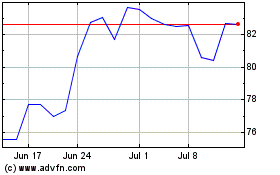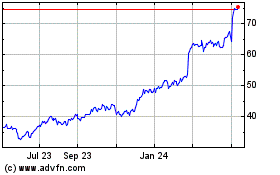By Jaewon Kang
Supermarkets are using pandemic-driven changes in shopping
behavior to accelerate the shift to e-commerce they have been
seeking but have been slow to realize in recent years.
Grocers are now devoting more of their floor space to fulfill
digital orders in response to customers' increased food consumption
at home and their growing reliance on online shopping.
Albertsons Cos., the country's second-largest grocer, is testing
the use of dozens of 9-by-12 foot temperature-controlled lockers in
select stores in Chicago and California for customers to collect
what they buy online. It is also introducing contactless payment in
all of its more than 2,200 stores.
"The principle of that is to make things easier for the
shopper," said Vivek Sankaran, chief executive of the Boise,
Idaho-based chain. He also said the pandemic has prompted the
company to make a fundamental change by prioritizing digital
investments.
While many such technology investments were under way in the
industry before the health crisis, food retailers are now making
bigger and faster bets in hopes of appealing to consumers who want
to avoid shopping in person or at least reduce the number of
visits. Online grocery sales in August were up about 74% from a
year earlier, according to data provider Nielsen.
The jump in digital sales is also creating new challenges,
however.
Industry executives say online purchases are less profitable
than those made in-store because of the extra costs associated with
fulfilling orders for customers. Grocers have to pay their own
staff to pick and package items on shoppers' behalf.
Delivering groceries to consumers is more expensive than having
people pick them up because of the labor and transportation
required, said Bill Bishop, co-founder of the consulting firm Brick
Meets Click. Compared to pickup, delivery typically adds $8 per
order to retailers' costs, he said. Lowering costs "is viewed as
the only way to move the online business to profitability," he
said.
For grocers, expanding pickup can help make that happen.
Midwest chain Hy-Vee Inc., for instance, is redesigning its
stores to handle more pickup orders, converting parts of the
customer-service area and building lanes of canopies outside its
stores. The company is also fast-tracking plans to add
self-checkout kiosks because customers are increasingly recognizing
their convenience, Chief Executive Randy Edeker said. It has added
more than 1,200 kiosks in total to about half of its stores.
Cub Foods, part of United Natural Foods Inc., hadn't previously
provided a place for collecting online purchases in parking lots
but now have four to eight slots at many locations. The Minnesota
chain is also devoting 7% to 10% of its square footage for staging
online orders, doubling the previous allocation.
Such investments allow Cub Foods to better satisfy shoppers, CEO
Mike Stigers said. "Customers want to come in and out. They know
exactly what they want," he said.
Alissa Grosso, who lives in Upper Black Eddy, Pa., has been
picking up her online orders at a nearby ShopRite since March. The
process has become smoother thanks to more parking space and a new
option to text store employees upon arrival.
"We've noticed they have improved since this started," said Ms.
Grosso, 44, referring to the coming of the pandemic.
In addition to building up their online services, grocers are
making other adjustments throughout the stores. Many are
reassessing inventory and expanding sections that have drawn more
purchases in recent months, including the frozen and meat
sections.
Anthony Hucker, chief executive of Southeastern Grocers Inc.,
said the retailer plans to increase the amount of square footage
for seafood, meat and produce in the new stores slated to open
later this year and early next year. The size of the sections will
vary depending on the location. He said there is more demand for
fresh items as consumers cook more at home.
Phoenix-based Sprouts Farmers Market Inc., which operates more
than 340 stores, said last month that it plans to give more space
to frozen, baking, cooking and meat products that have been popular
in recent months.
Others are allocating more shelf space for nonfood items and
larger sizes of groceries in high demand. Associated Food Stores
recently directed all of its stores to display personal protective
equipment at the end of aisles, said Darin Peirce, vice president
of retail operations for the cooperative.
SpartanNash Co. plans to double space for quart-sized yogurt
because it has been selling well among shoppers seeking larger
packages, said Thomas Swanson, executive vice president at the
company. The owner of Family Fares and Martin's chains is also
offering more space for larger-sized spirits.
"We're repurposing all the space we can," Mr. Swanson said.
Write to Jaewon Kang at jaewon.kang@wsj.com
(END) Dow Jones Newswires
November 04, 2020 15:08 ET (20:08 GMT)
Copyright (c) 2020 Dow Jones & Company, Inc.
Sprouts Farmers Market (NASDAQ:SFM)
Historical Stock Chart
From Mar 2024 to Apr 2024

Sprouts Farmers Market (NASDAQ:SFM)
Historical Stock Chart
From Apr 2023 to Apr 2024
